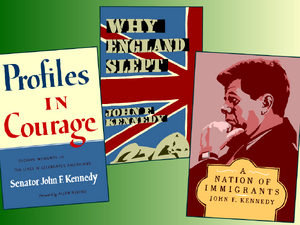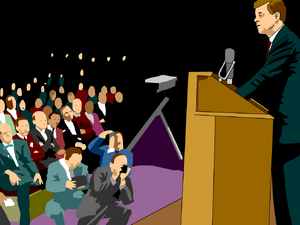| John F. Kennedy | |||
|---|---|---|---|
 | |||
| Airdate | September 6, 2007 | ||
| Curriculum | Social Studies | ||
John F. Kennedy launched in BrainPOP Social Studies September 6, 2007.
Summary[]
Starring[]
Transcript[]
Quiz[]
FYI[]
Arts And Entertainment[]

As Tim mentions in the movie, John F. Kennedy was a prize-winning author. Here’s a look at the three books he wrote!
Kennedy’s first book, Why England Slept, was adapted from the thesis he wrote as a senior at Harvard College. Published in 1940 when Kennedy was just 23 years old, the book examined the United Kingdom’s policies toward Nazi Germany during the 1930s.
During that particular time in history, the UK refused to fight the Nazis, even though Adolf Hitler was building up a powerful military machine and committing acts of aggression against his neighbors. Kennedy’s father was the American ambassador to the UK during the 1930s, and Kennedy himself spent a significant amount of time there, so it was a topic he knew a lot about.
Kennedy’s second book, which earned him the Pulitzer Prize, was Profiles in Courage. Published in 1956, it told the stories of eight U.S. Senators who defied public opinion and their own political allies to do what they thought was right. Profiles in Courage is still read in history classes today — but the book’s authorship is shrouded in controversy.
Kennedy claimed to have written it while recovering from back surgery, but a popular rumor held that it was actually ghostwritten by Theodore Sorenson, one of Kennedy’s speechwriters. Sorenson put the matter to rest in his 2008 autobiography, when he admitted that he did indeed write much of Profiles in Courage — and that Kennedy paid him handsomely for his effort.
Kennedy published his third book in 1958. Called A Nation of Immigrants, it analyzed the importance of immigration in American history and pushed for the reform of American immigration policy.
Way Back When[]

On August 2, 1943, PT-109 was one of 15 light torpedo boats patrolling the area around the Solomon Islands in the Pacific Ocean. At 2:30 a.m. on a dark, moonless night, a Japanese destroyer appeared, looming just a few hundred meters away.
Lieutenant John F. Kennedy attempted to steer PT-109 out of the way, but there wasn’t enough time. In less than a minute, the destroyer collided with PT-109, wrecking it completely.
Two men were killed, and the other eleven crew members were forced to abandon ship. The crewmen who could swam more than five and a half kilometers to safety on a nearby island chain.
But several men were injured, including engineer Patrick McMahon, who was badly burned. Kennedy — a former member of the Harvard swim team — grabbed the strap of McMahon’s life vest in his teeth, and physically towed him the entire distance.
Kennedy spent the next three days swimming and canoeing from island to island, looking for food, fresh water, and the opportunity for rescue. Finally, he encountered two native islanders who had been working as scouts for the Allies.
The islanders agreed to relay a message from Kennedy to Allied commanders, but Kennedy didn’t have a pencil or paper. So the islanders showed him how to scratch it into the husk of a coconut — and then delivered the message!
A rescue mission was organized, and all the survivors of PT-109 were brought to safety on August 8. Kennedy received the Navy and Marine Corps Medal for his troubles, along with a Purple Heart. He also held on to his lucky coconut — when he was President, he kept it (pictured) in the Oval Office!
In Depth[]

One of John F. Kennedy’s lasting achievements as President was the creation of the Peace Corps, a government-sponsored organization that sends American volunteers to help people in developing countries.
Kennedy first proposed the Peace Corps during his 1960 Presidential campaign, in a late-night speech to 10,000 students at the University of Michigan. “How many of you who are going to be doctors, are willing to spend your days in Ghana?” he asked. “Technicians or engineers, how many of you are willing to work in the Foreign Service and spend your lives traveling around the world?”
Kennedy also mentioned the new idea in his inaugural address, and then officially created the Peace Corps with an executive order in March 1961. That year, the first few hundred volunteers were sent to six countries.
Within five years, 15,000 volunteers were hard at work. Since then, more than 195,000 Peace Corps volunteers have served in 139 countries across the world!
Peace Corps volunteers perform a variety of tasks. For instance, some train teachers and teach English, while others help out with hygiene and sanitation.
Some help farmers learn better farming techniques, while others encourage economic opportunities. And many volunteers provide assistance to areas struggling with food shortages, environmental problems, and the scourge of HIV/AIDS.
If you’re interested in learning more about the Peace Corps, check out their Web site at peacecorps.gov. Who knows — maybe someday in the future, you too can pitch in and make a difference!
Did You Know[]

As he campaigned for President in 1960, John F. Kennedy didn’t only have to overcome voters’ worries about his youth and inexperience — he also had to overcome their fears about his religion.
Kennedy was Roman Catholic, and the nation had never had a Catholic President before. Unfortunately, anti-Catholic bigotry was a real issue back then. Some people wrongly believed that a Catholic President would be forced to take orders from the Pope, the head of the Catholic Church.
One Protestant denomination condemned Kennedy’s candidacy outright. Some members of Protestant churches attempted to mail anti-Catholic literature to millions of homes. There was even talk of a nationwide day of anti-Kennedy sermons in certain churches.
Kennedy knew that he could not be elected in this environment, so he sought to soothe the fears of the nation’s Protestant majority. In September 1960, he traveled to Houston, TX, to give an important speech in front of the Greater Houston Ministerial Association, an association of Protestant clergy members.
In the 12-minute speech, Kennedy reassured the audience that he would be able to keep his faith separate from his official duties as President. He reminded the audience that he wasn’t the Catholic candidate for President — he was the Democratic candidate, who happened to be Catholic.
“I believe in an America where the separation of church and state is absolute…an America that is officially neither Catholic, Protestant, or Jewish,” Kennedy told them, adding, “I believe in an America where religious intolerance will someday end; where all men and all churches are treated as equal.”
The speech did a lot to reassure Protestants that Kennedy would not let his religion influence his decision-making, and he won the election.
Famous Faces[]

Several members of John F. Kennedy’s family have served in politics. Here’s a look at some of them.
Robert F. “Bobby” Kennedy (1925 – 1968): President Kennedy’s younger brother served as his Attorney General. In 1966 he ran for, and won, a U.S. Senate seat from New York, and over the next couple of years he changed from a tough, no-nonsense prosecutor into an advocate for the poor and disenfranchised. With the Vietnam War dominating the political conversation, he ran for the Democratic presidential nomination in 1968 as an anti-war candidate. Tragically, he was assassinated in June of that year in Los Angeles.
Edward M. “Teddy” Kennedy (1932 – 2009): JFK’s youngest sibling was a U.S. Senator from Massachusetts. He was first elected in 1962, and was re-elected eight times after that, serving until his death in 2009. He was known as “The Lion of the Senate” for championing liberal causes. During his long career, he helped pass laws regarding immigration, cancer research, health insurance, disability discrimination, civil rights, education, and volunteering.
Patrick J. Kennedy (1967 – ): Edward Kennedy’s son and John F. Kennedy’s nephew, Patrick J. Kennedy has represented Rhode Island’s 1st District in the House of Representatives since 1995.
Joseph P. Kennedy II (1952 – ): A son of Bobby Kennedy’s and another nephew to JFK, Joseph P. Kennedy was a Congressman from the 8th district of Massachusetts from 1987 to 1999.
Kathleen Kennedy Townsend (1951 – ): The eldest of Bobby Kennedy’s 11 children, JFK’s niece Kathleen Kennedy Townsend served as the lieutenant governor of Maryland from 1995 to 2003.
Clockwise from top left: Robert Kennedy, Edward Kennedy, John F. Kennedy, Patrick Kennedy, Joseph Kennedy, Kathleen Kennedy Townsend.
FYI Comic[]

